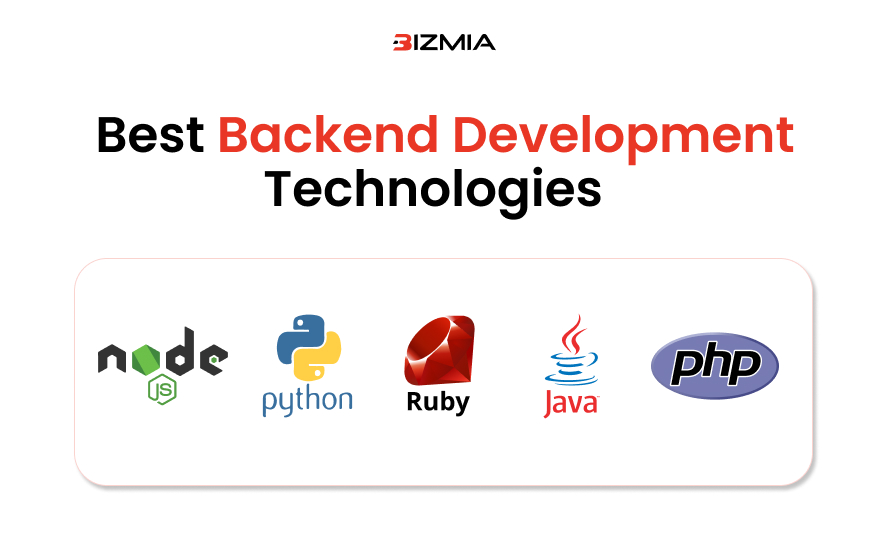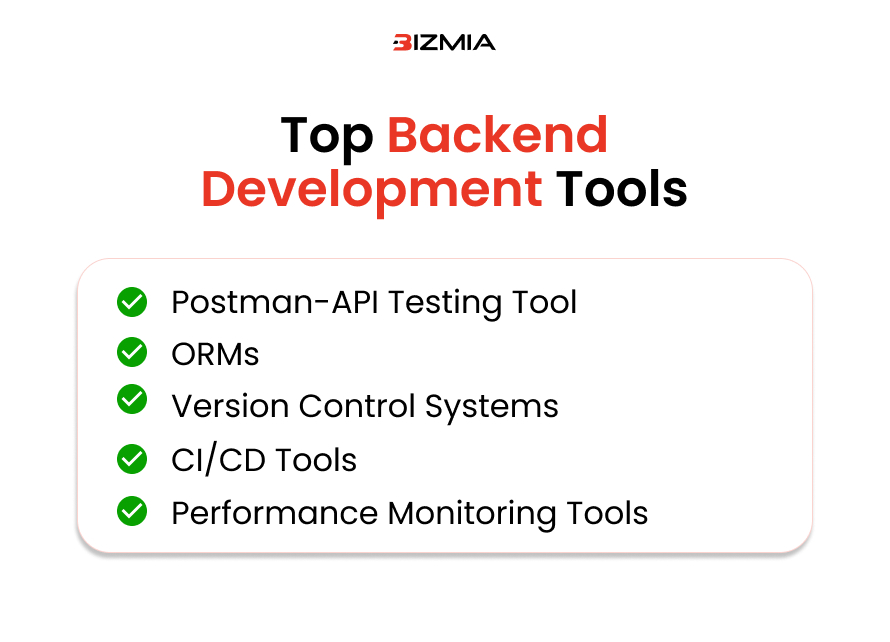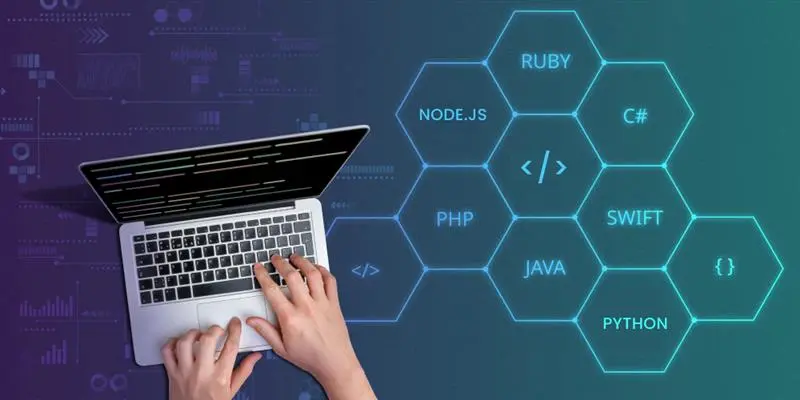An invisible engine that powers every web application is formed by backend development technologies. These technologies are the cornerstone of building scalable, fast, and secure web applications. They are in high demand due to their capability to process complex data logic. This blog explains all the top backend development technologies including tools, languages, frameworks, and best security practices.
Backend Development: A Brief Intro
The backend development refers to the server-side portion of web development. Although it is not visible to users, it is crucial to maintain the application’s functionality. Moreover, it takes care of managing databases, writing server-side logic, and designing APIs that connect frontend and backend data processes.
Web developers utilize multiple backend development tools, programming languages, and databases to make sure that data can be easily created, deleted, updated, or read as per the requirement. Also, backend web development is responsible for performance optimization, server configuration, data validation, and authentication. It also maintains the application’s overall security and stability.
Essential Components of Backend Development
Before getting into the details of backend technologies let’s see what the core components of backend development are:
- Database: Involves in data storage that can be utilized and manipulated by web apps
- Server: This part processes requests coming from clients and hosts applications.
- Application Logic: Manages decision-making and controls data processing
- APIs: Facilitate data exchange between frontend and backend
Best Backend Development Technologies
The best backend technologies for web development include scripting languages, frameworks, and tools. The selection of a suitable development stack depends on various things like project requirements, scalability, development speed, and team expertise. We are mentioning some top technologies that you can consider for the backend development of your web projects:
1. Node.js
This one is a strong JavaScript runtime enabling developers to use JavaScript for server-side development. It’s ideal for building real-time scalable web apps due to its non-blocking event driven I/O model. Moreover, Node.js is quite famous among developers or businesses who want to rely on a single language for both backend and frontend.
Some of its key advantages include high performance, npm packages, frequent updates, and active community support. You can leverage these key advantages by taking expert Node.js developers on board.
Here is an example of how you can write code for backend development:
const express = require ( ‘express’ ); const app = express ( ); app . get ( ‘ / ’, ( req , res ) = > res . send ( ‘ Hello from Node.js backend!’ )); app . listen ( 3000 );
2. Python
Readability and simplicity are the two key qualities of Python language making it popular among developers. Django framework of Python enables rapid development, practical, and clean design as well. On the other hand, FastAPI is a relatively new framework that builds performant REST APIs.
Moreover, it is easy to understand, good for data-intensive applications and machine learning, and has built-in tools for user authentication, security, and admin interfaces. Some popular use cases include data dashboards, APIs, machine learning models, and web applications.
An example of FastAPI usage:
from fastapi import FastAPI
app = FastAPI ( )
@ app . get ( “/ ” )
def read_root ( );
return { “ message ” : “ Hello from FastAPI” }
3. Java
For enterprise-level backend systems, Java has been a favorite choice. Sprit Boot, which is a Java-based web development framework, makes development easy by offering embedded servers, integrations, and pre-configured templates. Moreover, it’s dynamic and secure to work with and backs microservices architecture, that can be done easily by hiring expert Java developers.
Important use cases include banking systems, complex business logic implementation, and complex applications.
You can follow this example for backend development with Spring Boot:
@ RestController
@ SpringBootApplication
public class App {
public static void main ( String [ ] args ) {
SpringApplication . run ( App . class , args );
}
@ GetMapping ( “ / ” )
public String home ( ) {
return “ Hello from Spring Boot!” ;
}
}
4. PHP
An advanced PHP framework, Laravel facilitates the development process with the help of powerful features and syntax. This framework follows MVC pattern and takes care of everything required to build full-featured applications.
Its key advantages include authentication, routing, and caching, CLI making repetitive tasks easy, and eloquent ORM facilitating database interactions. Some use cases include e-commerce platforms, SaaS products, and content management systems.
Example:
Route :: get ( ‘ / ’ , function ( ) {
return ‘Hello from Laravel’ ;
});
5. Ruby
For rapid development of web applications, Ruby on Rails is an ideal platform. Moreover, it has all the tools needed to design a complete web application from background jobs to database migrations. Moreover, it offers faster development with less code, supportive community, and excellent testing tools.
Some use cases include social media applications, MVPs, and startups.
Here is an example of how you can use Ruby on Rails:
class HomeController < ApplicationController def index render plain : “Hello from Rails” end

Supporting Backend Development Technologies
Backend web development is supported by various technologies to ensure scalability, security, and optimal performance. These technologies take care of caching, server management, data storage, and messages.
1. Databases: For structure data, relational databases like PostgreSQL and MySQL are used. For semi structured or unstructured data, NoSQL databases like Cassandra and MongoDB are more suitable.
2. Caching Systems: Through caching, by storing frequently accessed data in memory, performance is improved. For caching systems Memcached and Redis are the popular choices.
3. Message Brokers: Asynchronous communication between services is enabled by message brokers. The most widely used message brokers are Apache Kafka and RabbitMQ. They also make applications more scalable and resilient.
4. Management: Powerful web servers manage load balancing, client requests, and static file delivery. Prominent server systems include Apache and NGINX.
Top Backend Development Tools
Numerous tools are involved in backend development including API testing tool Postman, ORMs, version control systems, CI/CD tools, and performance monitoring tools. Let’s get into details:
1. Postman-API Testing Tool
An API testing and collaboration tool, Postman enables developers to verify responses quickly, send requests, and test endpoints easily.
2. ORMs
Different Object Relational Mapping tools like Eloquent, SQLAlchemy, and Sequelize abstract the database layer. With ORMs developers can interact easily with databases by leveraging their scripting language’s syntax.
3. Version Control Systems
With the help of version control systems such as Git, GitLab/ GitHub it becomes easier to track changes. You can also roll back to previous versions and handle collaboration.
4. CI/CD Tools
Testing and deployment pipelines are automated with integration and deployment tools. Such tools include Jenkins, GitLab CI, and GitHub Actions.
5. Performance Monitoring Tools
With performance monitoring tools you can have full insight into server performance, user metrics, and error rates. These tools include New Relic, Grafana, and Prometheus.

Some Use Cases
Let’s have a look at the given table for some popular use cases of backend technologies for web development:
| Use Case | Development Stack |
| Real-time applications | Redis+ Node.js+Socket.io |
| Enterprise applications | Spring Boot+Java+OracleDB |
| E-Commerce sites | Laravel+PHP+MySQL |
| Data intensive Apps | Django+Python+PostgreSQL |
| Social Networking Sites | PostgreSQL+Ruby on Rails+Elasticsearch |
Security in Backend Development
In backend development, security is of prime importance. If the backend portion is compromised, it may damage user trust or expose sensitive data. Strict security measures should be followed by backend developers to ensure security. Such measures are:
- For encrypted communication use HTTPS
- Sanitize and validate all user input
- Password hashing with algorithms like bcrypt
- For detection of unusual activity deploy rate limiting and logging
You can use JWT tokens to have secure authentication:
const jwt = require ( ‘ jsonwebtoken ’ );
const token = jwt . sign ({ userId : 1 } , ‘ secret ’ , { expiresIn : ‘ 1h ’});
Trends and Future of Backend Development Technologies
Staying updated with the latest trends and technologies can help you to be on a competitive edge:
- Serverless computing is possible through services like Google Cloud Functions and AWS Lambda.
- GraphQL is a flexible alternative to REST APIs. Users can query the data that they need.
- Multiple machine learning models are being integrated into backend development systems for providing intelligent automation and personalization.
Conclusion
All the top technologies used in backend development are the foundation of scalable and modern web applications. Whether you are designing large-scale enterprise-level solutions or real-time apps, opting for the right backend web development technologies is the key. By knowing and understanding the backend technologies for web development and how to utilize them, developers can design secure and high-performing web applications.
FAQs
1. What technologies are commonly used in backend development?
Common technologies for backend development include Node.js, Django, Laravel, Spring Boot, and Ruby on Rails. Different databases like MongoDB and PostgreSQL and tools like Redis, NGINX, and Docker are also popular for backend web development.
2. Is backend development difficult in comparison with frontend development?
Both parts of web development have different challenges. Frontend takes care of user interface and experience. On the other hand, backend development caters to data processing, security, and logic.
3. How can I choose the right backend technology?
For selecting the right backend technology start by determining your project size, considering expected traffic, skill set of developers, scalability, and performance requirements and make the right choice.












